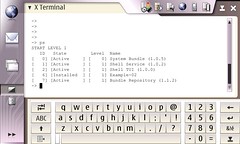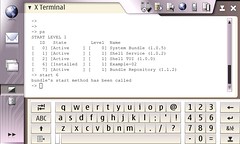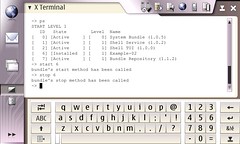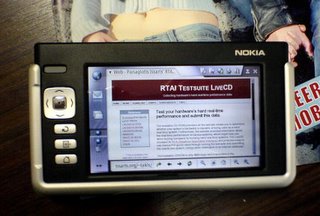This is a short howto, explaining how to setup User Mode Linux for simple Linux kernel module development and experimentation. I'm using the current Linux kernel 2.6.15 version (actually, todays GIT tree :) )
I like to keep my filesystem structure nice and clean, which is why I tend to use multiple partitions and directories for separate things. I've got a /usr/local/src directory which contains the linux-2.6 subdirectory contains the Linux kernel sourcecode. All my builddirectories are stored in /mnt/build, and so the first thing to do is to create a new entry for the Linux 2.6 UML build:
mkdir /mnt/build/linux-2.6-um
Next, enter the Linux kernel sourcecode directory:
cd /usr/local/src/linux-2.6
We'll start from the default UML configuration file for the kernel:
cp arch/um/defconfig /mnt/build/linux-2.6-um/.config
Use the defaults from that default config file:
make oldconfig ARCH=um O=/mnt/build/linux-2.6-um/
In case there's anything you want to change in the configuration of the UML kernel, start
the configuration menu:
make menuconfig ARCH=um O=/mnt/build/linux-2.6-um/
Now, we're set to do the actual building of the kernel. This will take a while...
make ARCH=um O=/mnt/build/linux-2.6-uml/
We need a disk image for the UML kernel to use. So, we'll create one. There's many ways to do this, this is a rather simple one.
First create an empty file which will kind of represent a disk drive (or actually a partition on a diskdrive):
dd if=/dev/zero of=/usr/tmp/sarge.ext2 bs=1M count=500
Put a filesystem on this partition, ext2 is fine for such a simple development system:
mkfs.ext2 /usr/tmp/sarge.ext2
Mount the filesystem image using loopback:
mount /usr/tmp/sarge.ext2 /mnt/loop/ -o loop
Copy an existing Linux distribution in this mounted filesystem image:
cp -var /usr/chroots/sarge/* /mnt/loop/
Move into the mounted filesystem and create the needed device nodes for UML:
cd /mnt/loop/dev
./MAKEDEV ubd
Next we'll install the kernel modules into the mounted filesystem:
cd /usr/local/src/linux-2.6
make modules_install O=/mnt/build/linux-2.6-uml ARCH=um INSTALL_MOD_PATH=/mnt/loop/
And finally, umount the filesystem image:
umount /mnt/loop/
Make a link named root_fs to your new partition image:
cd /usr/tmp
ln sarge.ext2 root_fs
Start the new UML kernel (and in this case, skip the default initscripts to get a real quick boot):
/mnt/build/linux-2.6-uml/linux init=/bin/bash
On the host system, create a directory for sharing files with the guest:
mkdir /tmp/forguest
In the guest system, mount this:
mount none /tmp -t hostfs -o /tmp/forguest
Now, any file appearing on the host system in /tmp/forguest, will also appear within the guest system in the /tmp directory.
Write whatever kernelmodule code (which doesn't actually access hardware since we're using UML)
you want in the /tmp/forguest directory.
Execute the following command once:
make -C /mnt/build/linux-2.6-uml/ modules ARCH=um
Build the module with the following command:
make -C /mnt/build/linux-2.6-uml/ SUBDIRS=$(pwd) modules ARCH=um
From the guest system, load the kernel module using:
insmod ./mymodule.ko
Remove it with:
rmmod mymodule
That's it! :)



